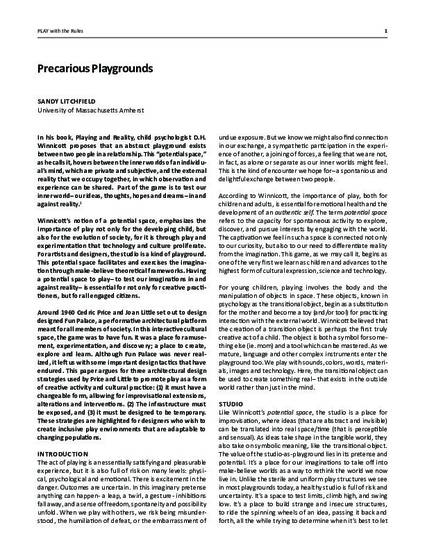
Article
Precarious Playgrounds
Association of Collegiate Schools of Architecture
(2018)
Abstract
In his book, Playing and Reality, child psychologist D.H. Winnicott proposes that an abstract playground exists between two people in a relationship. This potential space, as he calls it, hovers between the inner worlds of an individual’s mind, which are private and subjective, and the external reality that we occupy together, in which observation and experience can be shared. Part of the game is to test our inner world– our ideas, thoughts, hopes and dreams– in and against reality.
For architects, designers and artists, the studio is also a playground, one that facilitates and exercises the imagination through make-believe theoretical frameworks. On the one hand, it is a relatively safe place to take risks, experiment and play. On the other hand, it requires a significant commitment of time, energy, and money. The value of the studio-as-playground lies in its pretense and potential. It's a place for our imaginations to take off into make-believe worlds as a way to rethink the world we now live in.
Architecture itself can act as a playground too. In the 1960’s Cedric Price and Joan Little conceived of Fun Palace, a performative platform meant for all members of society. In this interactive cultural space, the game was to have fun. It was a place for amusement, experimentation, and discovery; a place to create, explore and learn. Although Fun Palace was never realized, it had an enduring influence on future buildings including the Centre Pompidou, and most recently, The Shed, by Diller Scofidio + Renfro. But what distinguishes Fun Palace as a play-space is its precarious nature, its indefinite and unpredictable form which allows for the spontaneous activity of reality testing.
This paper argues for three design strategies (rules) that promote play as a form of creative activity and cultural practice: (1) It must have a changeable form, allowing for improvisational extensions, alterations and interventions. Without a changeable form it risks becoming a monument or spectacle inspiring awe perhaps, but not intervention and agency. (2) The infrastructure must be exposed. Without an exposed infrastructure the design risks turning into a simulacrum or hyperreal construction (turn the fake castle at Disney World inside out). (3) It must be designed to be temporary. Without impermanence it risks banality, platitude or sheer exhaustion. The precarious infrastructure of Fun Palace yields important strategies for creating future cultural experiences that are fun, inclusive, and adaptable to changing populations.
Keywords
- Play,
- Playground,
- Cedric Price,
- Fun Palace,
- TAZ
Disciplines
Publication Date
October, 2018
Citation Information
Sandy Litchfield. "Precarious Playgrounds" Association of Collegiate Schools of Architecture (2018) Available at: http://works.bepress.com/sandy_litchfield/4/
